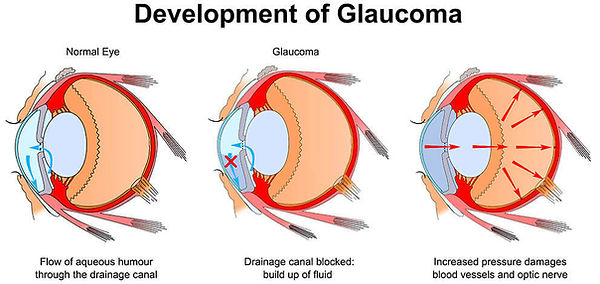What is Glaucoma?
Glaucoma is a group of eye conditions that damage the optic nerve, often due to high pressure inside the eye. It is one of the leading causes of irreversible blindness worldwide, but early detection and treatment can help protect your vision.

Glaucoma Types
Primary Open-Angle Glaucoma:
The most common form, it develops slowly and often without noticeable symptoms.
Angle-Closure Glaucoma:
A less common form that can occur suddenly and is considered a medical condition.
Normal-Tension Glaucoma:
Damage occurs even with normal eye pressure.
Secondary Glaucoma:
Caused by another condition, such as inflammation, injury, or medication use.
Symptoms
In the early stage, glaucoma often has no symptoms. As it progresses, you may notice:
-
Loss of peripheral (side) vision
-
Blurred or hazy vision
-
Seeing halos around lights
-
Eye pain or redness (in acute cases)
-
Sudden vision loss (in angle-closure glaucoma)
Causes
Glaucoma often occurs when the eye' s drainage system becomes blocked, leading to increased intraocular pressure (IOP). Risk factors include:
-
Age (over 60, or over 40 in certain populations)
-
Family history of glaucoma
-
High eye pressure (IOP)
-
Thin corneas
Selective Laser Trabeculoplasty (SLT)
SLT is a type of laser that is used to treat Glaucoma. It is a laser procedure done in the office to lower your eye pressure. High eye pressure can damage the optic nerve, causing glaucoma. Your eye pressure can be high because the drain in your eye is too slow. SLT makes the drain work better, which can lower your eye pressure.

SLT
Drainage Channel
How is the procedure performed?
-
The laser is done in office and takes only a few minutes.
-
You will sit at the laser machine, and your eye will be numbed with eye drops.
-
A lens will be placed on your eye, and a laser light will aim at the drain of your eye.
-
You may feel some mild stinging or pressure during the laser, but most patients are very comfortable
-
There are no injections or needles involved.
What are the risks?
SLT is a very safe procedure. However, with any procedure there are risks.
-
Sometimes your eye pressure may go up after the laser for a short time, but you may need more glaucoma drops or even surgery if the laser is ineffective.
-
You may experience some eye inflammation, and you may be given drops to control the inflammation for a few days.
What should I expect after the procedure?
-
After the laser, your vision may be blurry for a few hours. Plan to have someone drive you home after the laser, especially if both your eyes are treated.
-
You may be prescribed some anti-inflammatory eye drops to be used for a few days after the laser.
-
The laser does not lower your eye-pressure right away. It can take up to a few weeks to see a lower eye pressure.
